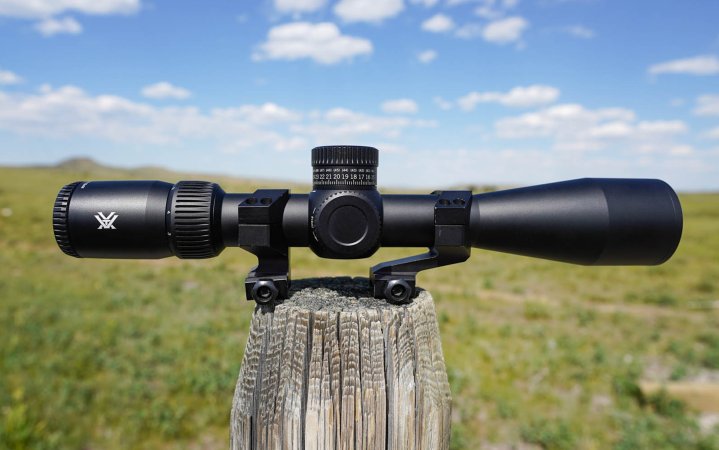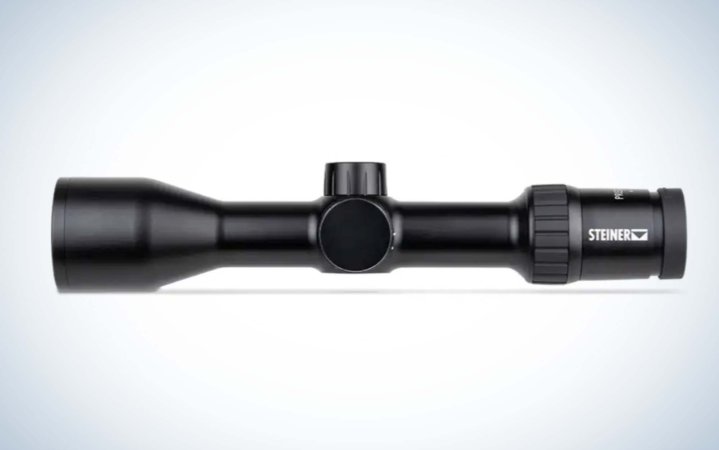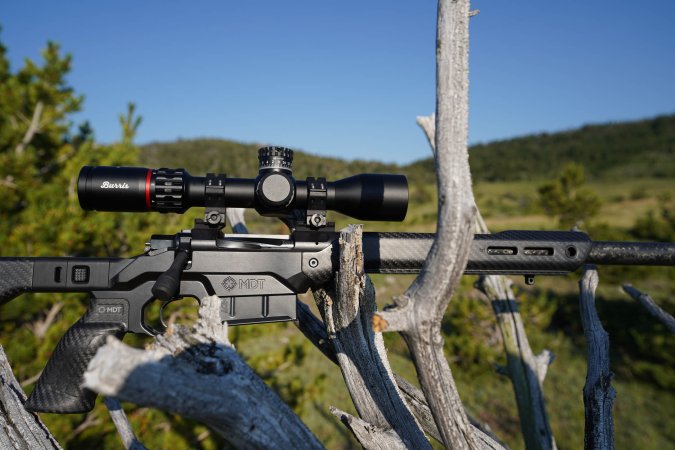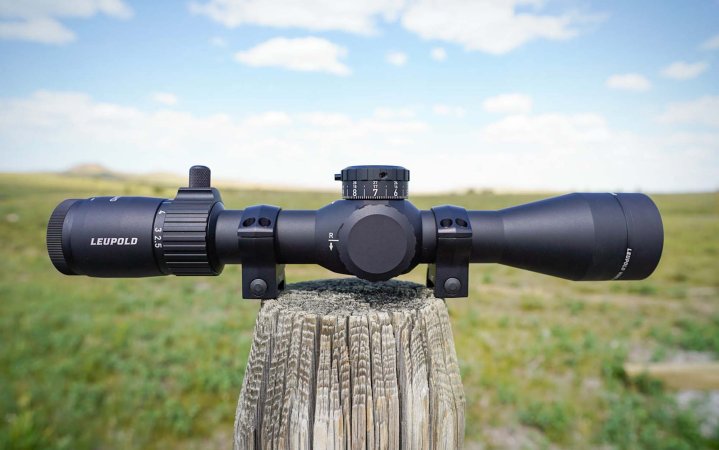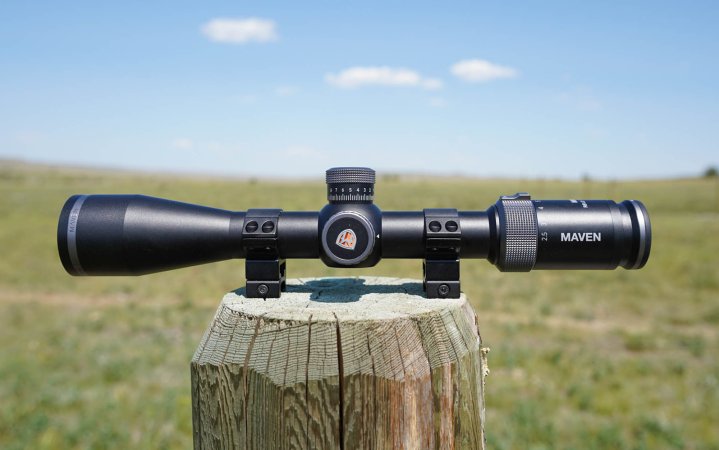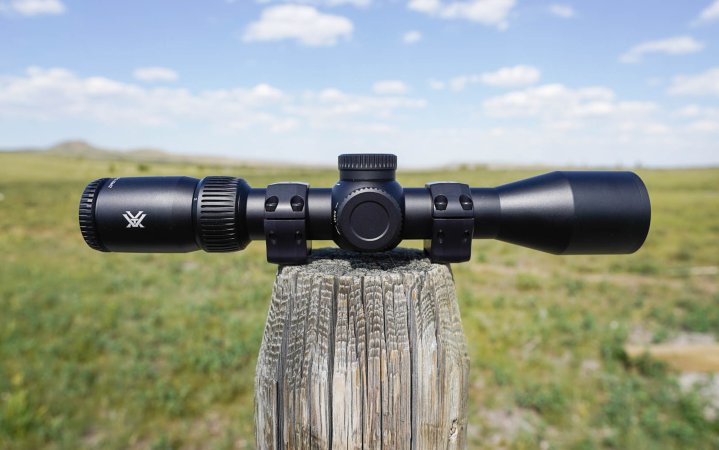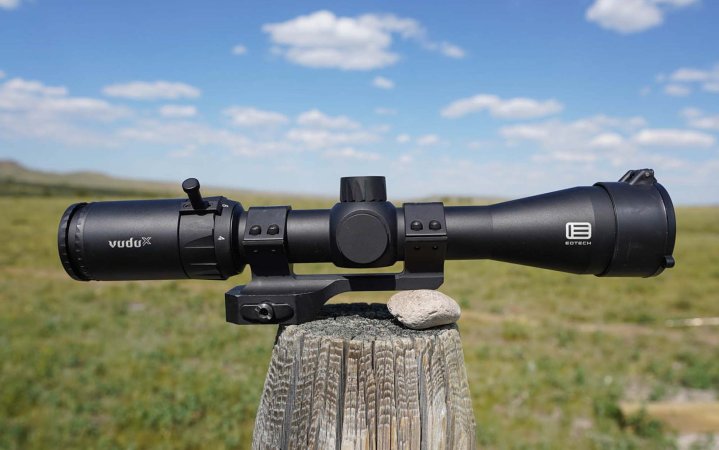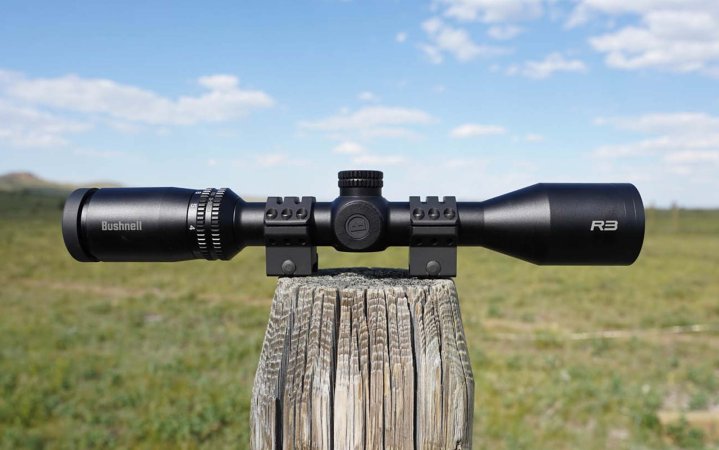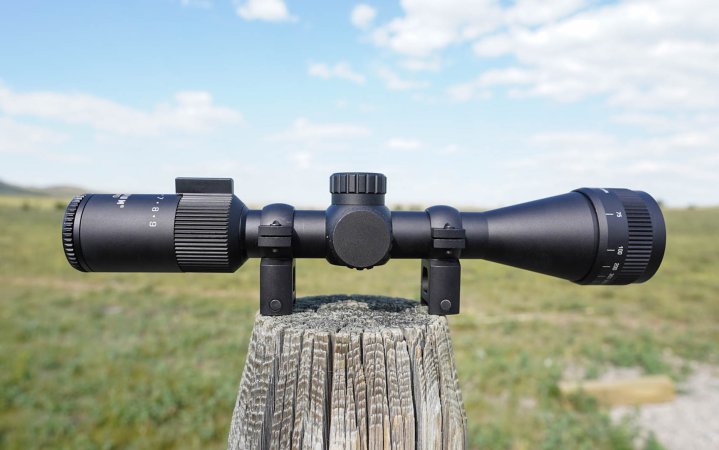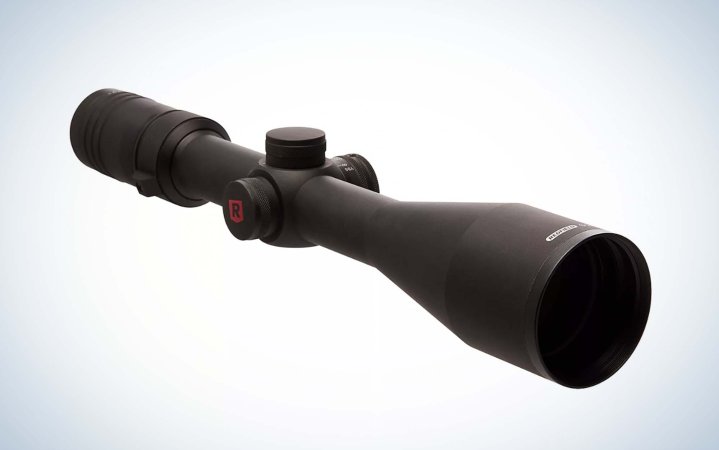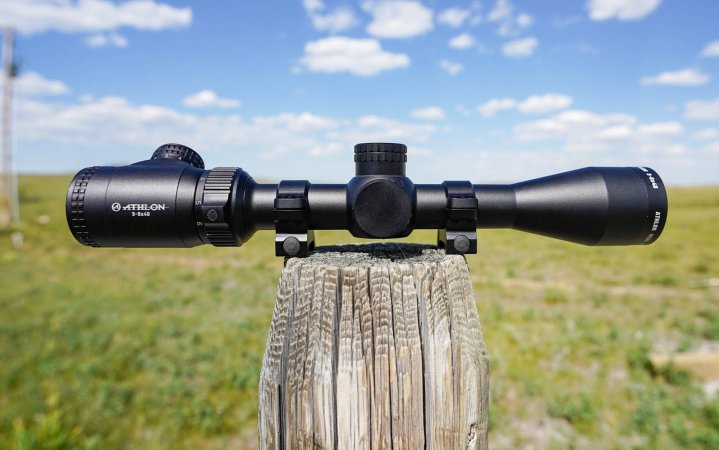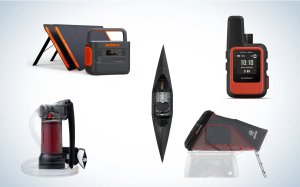We may earn revenue from the products available on this page and participate in affiliate programs. Learn More ›
Are you looking for a lightweight scope for your mountain rifle? Here are four or five new models to choose from. Maybe you want a scope with a first-plane reticle and exposed turrets so you can either hold or dial your aim as necessary. There’s a half-dozen of these long-rangers in our test. Or maybe you’re looking for a scope for a kid’s first rifle and have only $200 to spend. There’s a handful of choices here.
The collection of mid-power rifle scopes — I call them versatile scopes because of their wide utility — that are mainly configured for hunting is so large and messy this year that we figured we’d break the 18 submissions into price levels. It’s unfair, after all, to compare a $99 Redfield to a $2,100 Steiner. Price isn’t the perfect way to divide the class, but it’s how many of us shop for optics, and generally allows us to compare scopes of similar talents against each other.
At the top of class are premium scopes that cost over $1,000, and in some cases over $2,000. You’ll see some of the usual brands here —Steiner, Burris, Leupold, Maven. And at the bottom of the roster are budget scopes — six of them priced under $250 — that can be characterized either as appalling junk or exceptional values, depending on the unit. And in the middle are precious few ranging in price from $500 to $1,000, a market I wish the industry would better serve.
↓ Jump to Best Premium Hunting Scopes
- Editor’s Choice: Vortex Viper HD 3-15×44
- Best Over $1,000: Steiner Predator 4 4-16×44
- Best Versatile Electronic Scope: Burris Veracity PH 2.5-12×42
- Best for Pairing with a Thermal Clip On: Steiner H6Xi 2-12×42
- Best Tactical Hunting: Leupold Mark 4HD 2.5-10×42
- Best for Western Hunting: Maven RS1.2 2.5-15×44
↓ Jump to Best Mid-Price Hunting Scopes
- Best Overall: Zeiss Conquest V4 3-12×44
- Best for Whitetails: Vortex Viper HD 2-12×42
- EOTECH Vudu X
- Riton 5 Primal 2-12×44
↓ Jump to Best Budget Hunting Scopes
- Best Value: Bushnell R5 4-12×40
- Best Entry-Level: Bushnell R3 3-9×40
- Best Entry-Level Rimfire: Redfield Rebel 2-7×32
- Best Bargain: Monstrum Guardian 3-9×40
- Best Straight-Wall: Hawke Vantage IR Straight-Wall Marksman 3-9×40
- Best Budget Big-Game: Redfield Rebel 6-24×50
- Great Buy Straight-Wall: Athlon Neos Straight-Wall 3-9×40
How We Tested the Best Hunting Scopes

Because rifle scopes are essentially aiming devices, we evaluate them on a different basis than binoculars or spotting scopes, optical instruments that have broader utility. We’re interested in the precision of a rifle scope, so our scoring criteria gives more weight to attributes that achieve that goal.
We test optical performance, same as we do spotters and binoculars. But we spend more time on four criteria that we think are the beating heart of a solid rifle scope. Our interior aiming system considerations are reticle style and utility, illumination, reticle references, and visibility. Our exterior aiming system evaluation considers turret positivity and indexing, the scope’s zero stop, parallax control, and total adjustment range, or how far shooters can stretch the turrets’ elevation and windage clicks. We also test a range of attributes that we bundle under the heading precision, which includes turret tracking, return to zero, the trueness of the scope’s magnification, parallax, and field of view. And then we ask testers to rate a scope’s shootability, which considers eye relief, eyebox, the ease of use at various magnifications, and the scope’s versatility.

That last consideration — versatility — is probably the most meaningful in this category. We’re interested in scopes that can span a wide range of uses, from ringing steel at a mile to killing a twitchy mule deer at a quarter that distance. Target-shooting attributes are a plus, but so is portability, a clean but useful reticle, precise and positive turret clicks, illumination, and clear glass. We also reward scopes that can do triple duty as close-in rimfire target optics, mountain hunting companions, and long-range competition scopes.
We put all submissions through the same criteria. First, we measure optical resolution, using the diminishing black-and-white lines of a 1951 Air Force Resolution Target to score the optical performance of each submission. We also measure the low-light performance of each “versatile” scope by mounting them to tripods and focusing them as a group at 200 yards at a black-and-white resolution target at twilight, all in order to measure the brightness and sharpness of the glass and visibility of the unilluminated reticle.
We break our 10-point scoring into four general categories: optical performance (25 percent of total grade), aiming system (50 percent of total grade), design (15 percent), and value (10 percent). The average of these categories is the basis of our grades, detailed below.
Optical performance includes the resolution and low-light tests plus the more subjective assessments of image quality and brightness. Aiming-system performance assesses interior and exterior aiming system, precision, and that squishy shootability assessment. Design considers the exterior finish, interior blacking, mounting dimensions, and durability.
And then our price/value score rates how much scope — along with warranty and amenities such as rings, extra turrets, and lens covers — you get for your money. The rifle scope that gets the highest overall score wins our editor’s choice award for the best in the category; the optic with the highest price/value score wins our great buy recognition, and we give other awards based on specific attributes.
How We Grade Hunting Scopes

Our 100-point evaluation adds up to a total numeric score, but we translate those to grades for each submission. The optical performance grade combines the scores from resolution, low-light, and image quality. Our aiming system performance grade aggregates the interior/exterior aiming system, precision, and shootability scores. The design grade considers construction, innovation, versatility, and durability. And then the price/value grade is our value grade.
To earn an excellent grade, the average of that category must be 9 or higher, which is extremely hard to achieve. Very good is an average score of 7 to 9. A good grade is 5 to 7. Our fair grade is 3 to 5, and poor is anything under 3.
Best Premium Hunting Scopes: Reviews & Recommendations
Editor’s Choice: Vortex Viper HD 3-15×44
Score Card
- Optical Performance: Very good
- Mechanical Performance: Excellent
- Design: Very good
- Price/Value: Very good
Key Features
- 30mm tube
- Second-plane VMR-3 MOA-based reticle
- Pull-to-turn exposed elevation turret, capped windage turret
- Turrets tuned to .25 MOA clicks
- 102 MOA elevation adjustment (47 MOA with RevStop installed)
- 20 yards to infinity side parallax control
- Push-button center-dot illumination
- Price: $1,000
Pros
- 5x magnification range
- Versatile hash-based reticle available in MOA or MIL references
- At 11.8 inches and 23 ounces, a very light and compact scope
- Custom turrets available from Vortex
- Ships with sunshade and neoprene cover
- Optional zero stop is nice touch
Cons
- Relatively indistinct turret clicks
- Turret indexing is confusing
- Illuminated dot flares noticeably
With this center-of-mass scope, Vortex has built an all-arounder that can thrive on any Western hunt, but which can serve capably on a rimfire precision rifle, just about any deer rifle, or even ring distant steel in a pinch. That’s the very definition of versatility.
This is actually a hard balance to strike. Being the opinionated bunch we are, shooters will sniff at an MOA-based scope, but then complain that the MRAD competitor doesn’t have a second-plane reticle. Or a shooter might want a 3-18-power zoom range but prefers an exposed elevation turret. Or they demand a zero stop and a second-plane reticle but will absolutely reject capped turrets. It’s enough to drive a scope designer crazy.
Vortex introduced its new Viper HD line of scopes to the market this summer, with models in the 2-10×42, 3-15×44, and 5-25×50 configurations. The middle sibling reflects the best balance of portability, versatility, and attributes and wins our editor’s choice as the best versatile scope of the year.
Optically, these are fine scopes. While there’s nothing especially wow-worthy about the glass, there’s nothing that will distract from the scope’s job, and we detected no major flaring, edge distortion, or other aberrations. The Viper HD posted top scores in both our resolution and low-light testing.
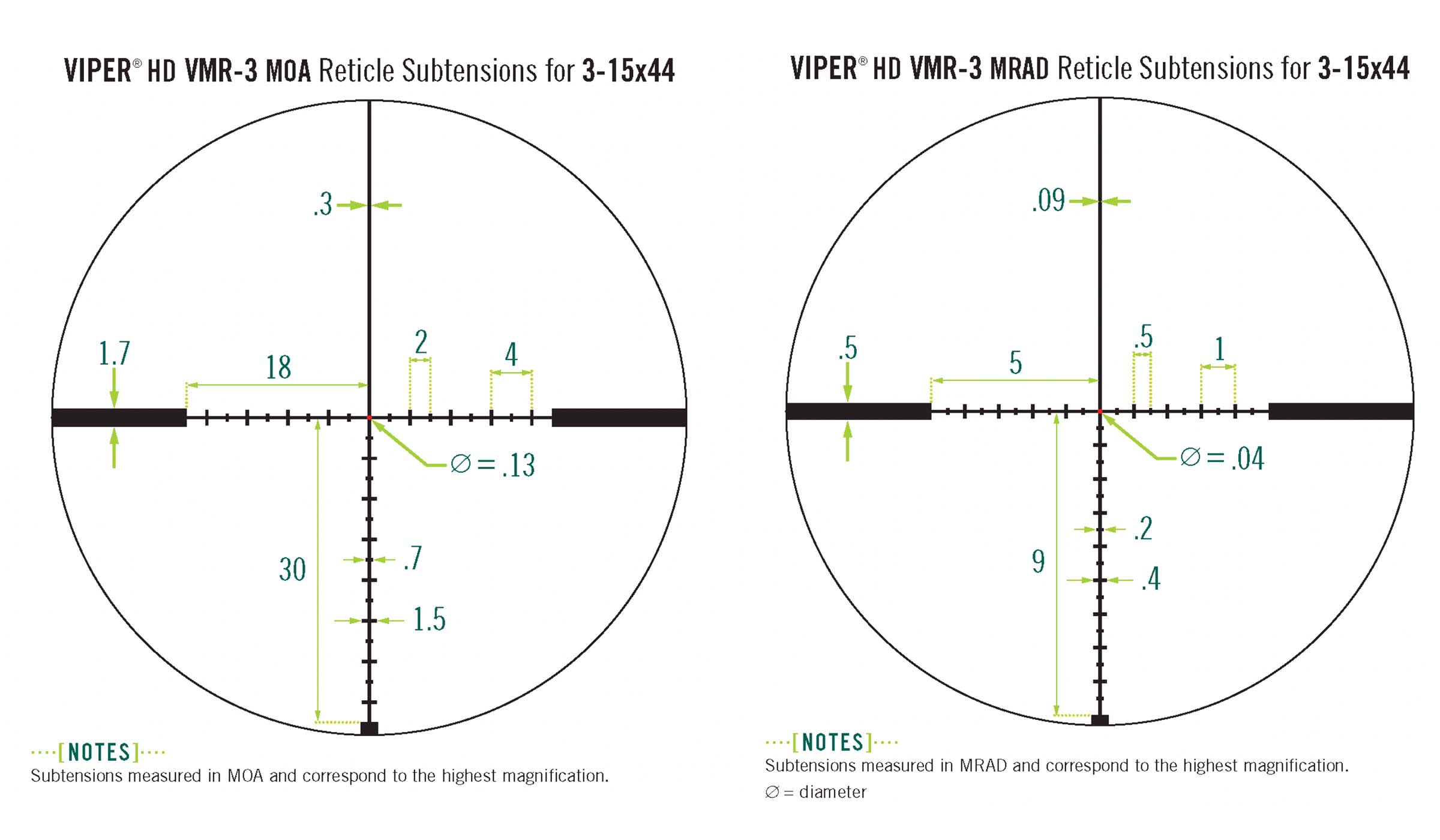
The reticle is a very good balance of speed and precision. While our test scope was delivered in MOA, the Viper HD is also available in an MRAD version, further confirming its versatility. The second-plane reticle is divided in 2 MOA (.5 MRAD) hashes, with 30 MOA (9 MRAD) elevation references and 18 MOA (5 MRAD) windage references on either side of the center cross.
Once you get familiar with the references, the scope delivers a nice balance of speed and precision. We also like the fine (.13 MOA/.04 MRAD) center dot, which is illuminated with a red light, activated by a push-button module and adjustable from a barely visible aiming point for low-light conditions or blazingly bright for daylight shooting.
Other clutch features include a 20-yards-to-infinity parallax control, which makes this a good choice for a precision rimfire rig. Vortex’s excellent RevStop zero stop can be removed or added as needed. The RevStop does substantially limit the elevation adjustment, reducing it from an impressive 102 MOA (30.5 MRAD) down to 47 MOA (18.9 MRAD). But for turret dialers who want a rock-solid stop, the RevStop is simple and effective. And for those who want to dial to the horizon, simply remove the RevStop and keep turning.
Of course, we found some shortcomings. The turret indexing is very busy, with squintingly fine references for two full revolutions. The turret gearing seems a little plasticky, delivering clicks that are a mushy and indistinct. And the center-point illumination is not coherent, meaning that it flares and bleeds into the reticle, especially at full intensity.
On the upside, we got an early version of custom turrets that Vortex has added as a free premium for the 3-15×44 Viper HD. Ours was tuned to the 40-grain .22 CCI bullets we shot, and worked perfectly, giving our testers an extra choice about whether to dial to distance or use reticle references to hold.
We liked the mounting dimensions of the Vortex, and the 44mm objective lens is sized about right for low-profile mounting on a variety of rifle types. At about $850 real-world street price, we realize this is a pricey scope, but it’s right in the middle of the field, and given all the versatility it delivers, we think it’s a good value on an excellent all-around hunting scope.
Read our full review of the Vortex Viper HD line for more info.
Best Over $1,000: Steiner Predator 4 4-16×44
Score Card
- Optical Performance: Very good
- Mechanical Performance: Excellent
- Design: Excellent
- Price/Value: Very good
Key Features
- 30mm tube
- Second-plane E3 ballistic reticle
- Low-profile capped turrets tuned to .25 MOA clicks
- Re-zeroable turrets
- 20 yards to infinity side parallax control
- 11-step red center-cross illumination
Pros
- At 18 ounces and 10.9 inches, very compact and light
- Reticle optimized for hunting conditions
- Smooth and positive controls
- Excellent glass
- Sized for use with clip-on thermals
Cons
- Fairly limited mounting dimensions
- Turrets are hard to turn
As most versatile rifle scopes grow in weight and length, in order to accommodate all the bells (illumination and side parallax) and whistles (exposed tactical turrets, huge magnification ranges) of the category, it’s refreshing to see a scope shrink in size but increase in performance.
That’s the take-away from this marvelous little workhorse from Steiner. The lightest 4-16x scope on the market, the Predator 4 is 25 percent shorter than its competitors while still delivering a useful magnification range and plenty of reticle adjustment. With capped controls and a tight build, this is a pure hunting scope that’s intended to be carried.

The heart of the Steiner is a familiar second-plane reticle, the E3 ballistic reticle that we’ve seen in Burris scopes. Makes sense, since Steiner and Burris are siblings, owned by the same Beretta Group. The reticle has three simple and clear elevation hashes with distance-informed windage dots. Zero your rifle at 100 yards, and the first hash represents a 200-yard hold, the second a 300-yard hold, and the lowest hash a 400-yard hold. The windage references conform to 5 and 10 mph right-angle wind values.
The low-profile turrets are re-zeroable, and while their small diameter makes them hard to turn, they’re tight and unobtrusive. We’d like to see a bit more texturing on the very smooth but mannerly controls.
Testers indulged fantasies about which rifle they’d pair with the Predator 4. Some thought its length is suited to an AR pattern, others a walk-about deer rifle. I’m already thinking of the ultralight mountain rifle I want to build around the Steiner. Like its big brother, Steiner’s H6Xi, also in the test, the Predator 4’s short length is intended to pair with a clip-on thermal sight, furthering its versatility.
At about $1,200, this is a pricey scope, especially when you consider its per-ounce price. But for a pure hunting scope that’s at home in a wide variety of rifles and in a range of scenarios, it’s one of the gems of this year’s field.
Best Versatile Electronic Scope: Burris Veracity PH 2.5-12×42
Score Card
- Optical Performance: Very good
- Mechanical Performance: Very good
- Design: Very good
- Price/Value: Good
Key Features
- 30mm tube
- First-plane 3PW Wind MOA reticle
- Digital heads-up display indicates elevation hold
- Clickless programmable elevation turret tuned to .25 MOA clicks
- Re-zeroable turrets
- 25 yards to infinity side parallax control
- Red center-cross illumination
Pros
- Extremely programmable and customizable
- Pairs with BurrisConnect mobile app
- Clickless elevation turret allows for fine tuning hold
- Excellent glass
- Useful even if battery dies
Cons
- Relatively tedious set-up
- Glass caused eye fatigue in some testers
- Function dial is easy to confuse with parallax knob
We struggled a bit with the first iteration of the Veracity PH, which was in last year’s test. The interface with the mobile app was glitchy, and the inputs didn’t seem to guide bullets precisely past about 300 yards. With this second generation of the smart scope Burris has simplified the interface, and we found it to be responsive, precise, and really fun to shoot once we had all the inputs in place.
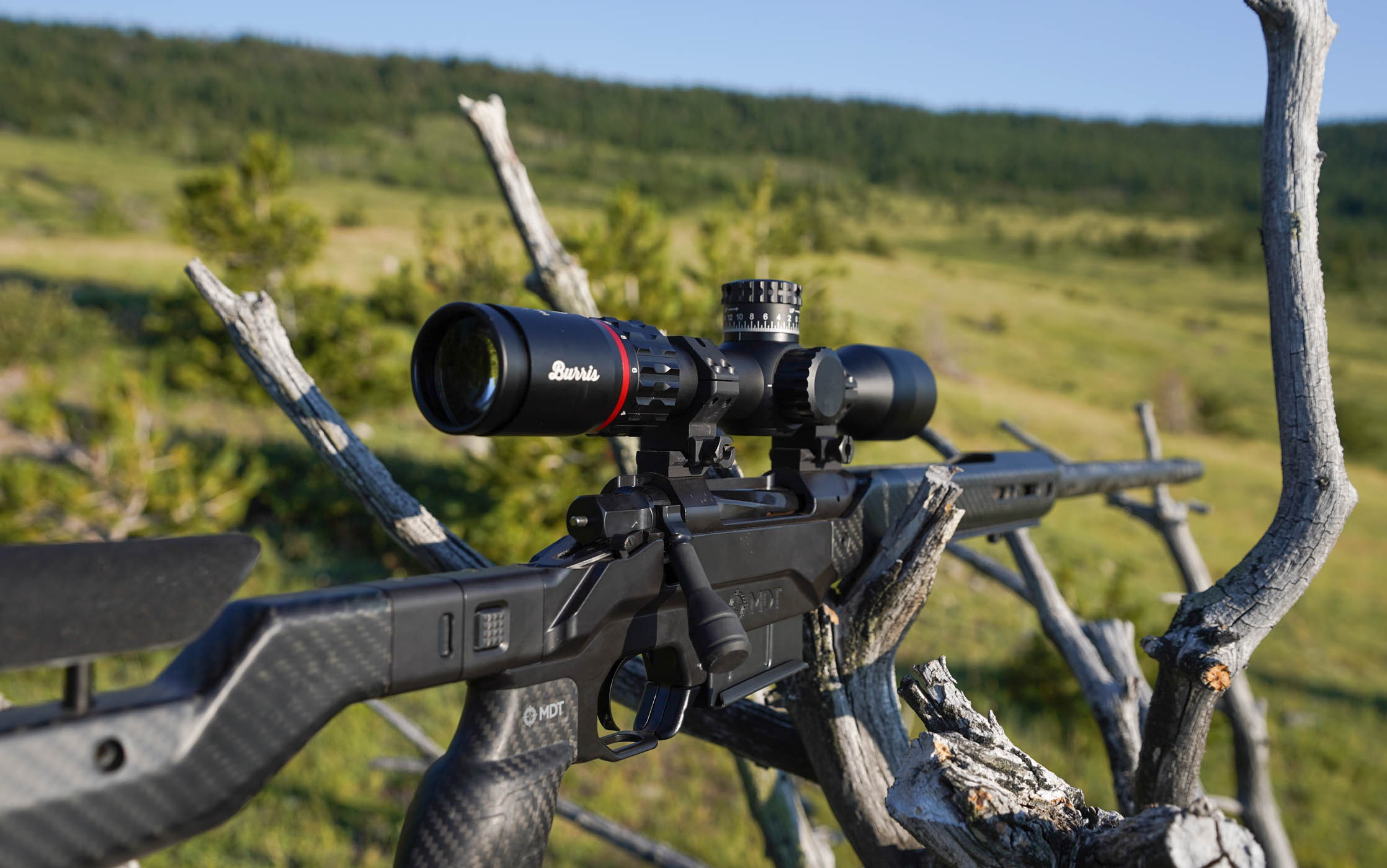
Like many ballistics solvers, you get out of the Veracity PH what you put in, meaning that you must have precise muzzle velocity, ballistic coefficient, and other inputs loaded into the Burris app in order to get the scope to guide a bullet’s parabola properly. But when you do, shooting precisely is a matter of porting the customized ballistics into the rifle, ranging your target, dialing the elevation knob to the appropriate yardage, holding where it tells you to, reading the wind, and delivering the bullet. We shot the Veracity PH on a wide range of rifles, including a 6.5 PRC chassis rifle, a 6.8 Western bolt gun, and a whole rack of .22 precision rifles, and found the system worked well across platforms.
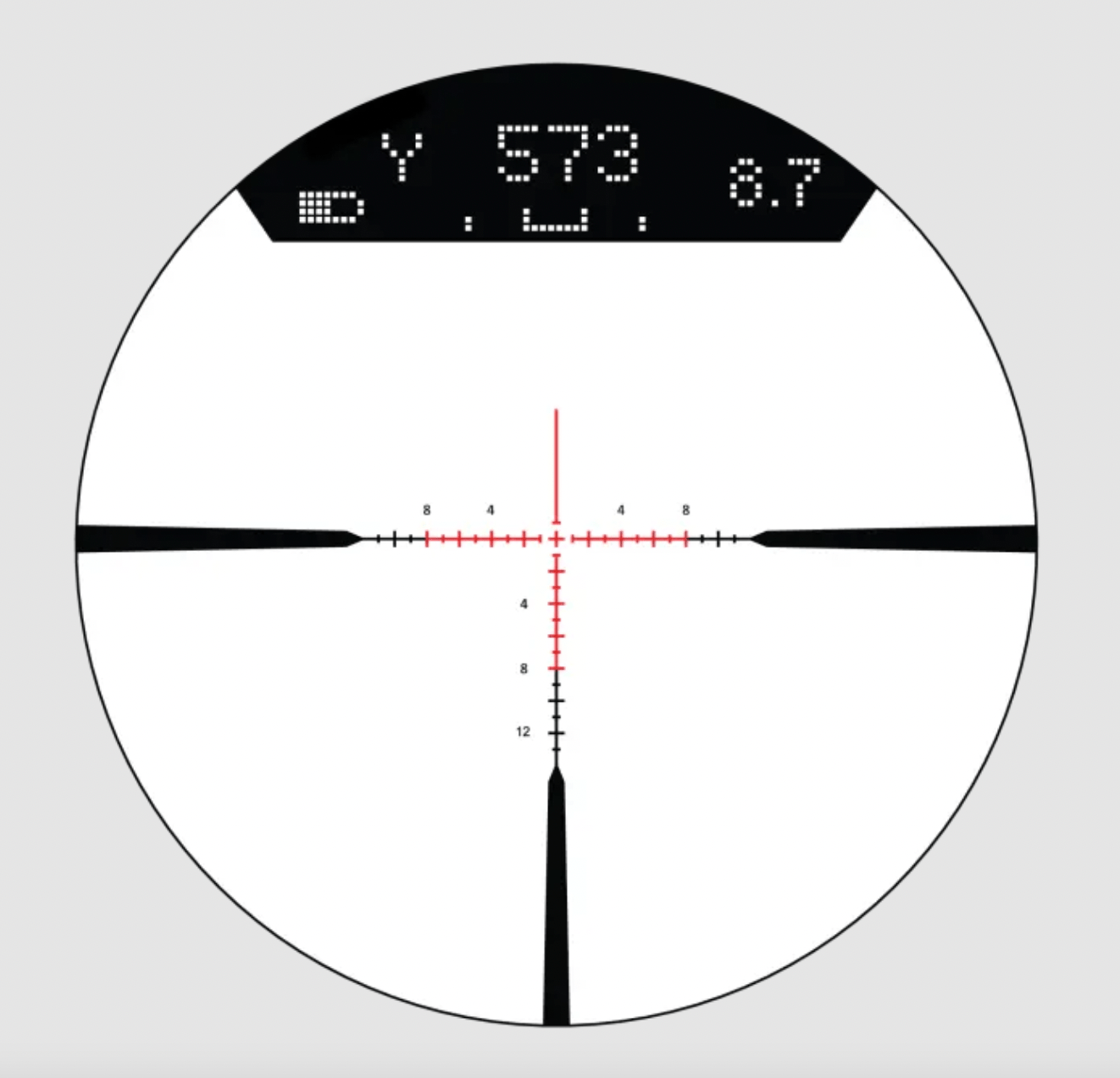
The electronic brains of the Veracity PH are the headliners of the scope, to the degree that it’s easy to forget its more pedestrian features. But the Burris has good glass, though it’s a little undercoated for our liking. The aggressively textured controls turn with precision. The reticle, with 12 MOA of windage holds on either side of the illuminated center cross, is useful, and we like the tapered posts for centering our eye on the target.
The main design flaw we noted is that the two left-side controls — the inside knob for parallax and the outside control for powering up the heads-up display, connecting to Bluetooth, and controlling illumination — are easy to mix up while a shooter is behind the scope. While trying to focus our target, we’d often turn off the unit, requiring a pause in shooting while we reconnected to the app.
But that’s one of the very few demerits we gave the Burris. At a little over $1,300, it’s pricey, but entirely in line with its abundant attributes.
The overall handling of the scope is good enough that the test team had a vigorous debate about whether the Veracity PH should win the category as the most versatile scope in this year’s field. Ultimately, its few demerits kept it from the top spot, but its wide utility, increased user-friendliness, and bullet-placing talents make the Veracity PH one of the most versatile scopes we’ve ever tested.
Best for Pairing with a Thermal Clip On: Steiner H6Xi 2-12×42
Score Card
- Optical Performance: Very good
- Mechanical Performance: Excellent
- Design: Very good
- Price/Value: good
Key Features
- 30mm tube
- First-plane MHR (Modern Hunter Reticle)
- Low-profile exposed elevation turret, capped windage turret
- Turrets tuned to .25 MOA clicks
- 70 MOA windage/elevation adjustment range
- 25 yards to infinity side parallax control
- 11-step red center-cross illumination
Pros
- 6x magnification range
- Versatile hunting reticle with elevation and wind holds
- At 11.8 inches and 23 ounces, a very light and compact scope
- Excellent turret indexing
- Ships with premium lens caps and throw levers
Cons
- Turret, parallax, and illumination knurling is finger-shredding sharp
- At $2,183, one of the most expensive scopes in our test
- Reticle references not visible until about 6x
Welcome to a new configuration of European rifle scope. This Steiner packs a 6x zoom range, first-plane reticle, excellent illumination, and best-in-class glass in a package less than 12 inches long. Its compact build is designed to function as a daylight scope, but then accept a clip-on thermal device for night hunting. The short length enables shooters to easily reach the clip-on controls while staying in the scope’s eye box.
We didn’t test the scope’s capability as a clip-on slave, but the Steiner, which is engineered, machined, and assembled in Greeley, Colorado, in operations shared by Burris, wowed us with all-around handling and excellent glass.
“It’s one of the rare scopes that I could see on an AR and on a custom sheep rifle,” said tester Todd Netto, who added that it handles like an LPVO but “has way more reach and usefulness.”
The glass is first-rate and starts to justify its over-$2,000 price tag. Little touches like a locking diopter, optional capped elevation turret, and two different styles of throw lever add to its handling. The Steiner’s compactness is a huge attribute, and while we complained about the aggressive knurling of the H6Xi’s turret, parallax, and illumination controls — “shark-tooth turrets could legit cut someone,” says tester Luke Coccoli — we liked the positivity of the controls.

What we didn’t like is a pretty big deal. At first glance, the MHR (Modern Hunting Reticle) is both useful and familiar, looking a lot like Burris’s excellent E3 reticle. For those of us who want just a few references in a hunting reticle, it’s a very appealing design. But it’s also a strange mash-up of references and adjustability, especially in its first-plane arrangement.
The .5 MOA center cross allows for precise aiming, and the windage references, with 2 MOA on either side of the center, are useful. But the holdover references are a strange mix of MOA and bullet-drop that get wider the lower they are on the vertical stadia, as you’d expect of a BDC (Bullet Drop Compensator). Combined with the exposed elevation turret (though, as we mentioned, there’s an optional cap), the configuration confuses rather than simplifies a hunting situation.
References of the first-plane reticle aren’t visible until about 6x, and even at full 12x magnification, the references are hard to see, even with the red illumination fully blazing.
We’d like to say that all the other excellent attributes of the Steiner compensate for an underwhelming reticle, but given that the reticle is the heart of the optic, we had to remove the H6Xi from our editor’s choice selection as the best versatile scope of the year. But it remains a top choice, especially for hunters who want a wonderful daylight scope that can easily transition to the night.
Best Tactical Hunting: Leupold Mark 4HD 2.5-10×42
Score Card
- Optical Performance: Very good
- Mechanical Performance: Excellent
- Design: Good
- Price/Value: Good
Key Features
- 30mm tube
- Available in second-plane or first-plane TMR (Tactical Milling Reticle)
- Exposed elevation turret with Zero Lock
- Capped windage turret
- Turrets tuned to .1 MRAD clicks
- 85 MOA (24.7 MIL) elevation adjustment range
- Fixed 150-yard parallax
- Eight-step center-reticle illumination
Pros
- 4x magnification range
- Versatile hunting reticle with elevation and wind holds
- At 12.5 inches and 21 ounces, a very light and compact scope
- Excellent turret indexing
- Smooth and precise controls
- Push-button illumination has auto-shutoff
Cons
- Without manual parallax setting, some focus issues
- Reticle illumination could be brighter
The recent trend in all-around rifle scopes is to push the higher end of their capabilities, adding to hunting scopes’ attributes for precision target work. So it’s refreshing to see versatility at the other end of the performance spectrum, with short- to medium-range target work combined with small-game to deer hunting chops.
This nimble new scope from Leupold, one of the configurations in the new Mark 4HD line, capably bridges use-cases from AR carbine work to 3-gun competitions to hunting in just about every place deer live. The Mark 4HD line uses the same excellent glass and coatings from the pricier Mark 5HD line, but in a trimmer build and at a more accessible price.
The 2.5-10x scope is so versatile, it’s hard to pin down specifically where it’s at its best. Is it a designated marksman scope for mid-distance precision work on an AR platform? Is it as a fun competition scope? Or is it a mountain-hunting optic atop a custom sheep rifle?
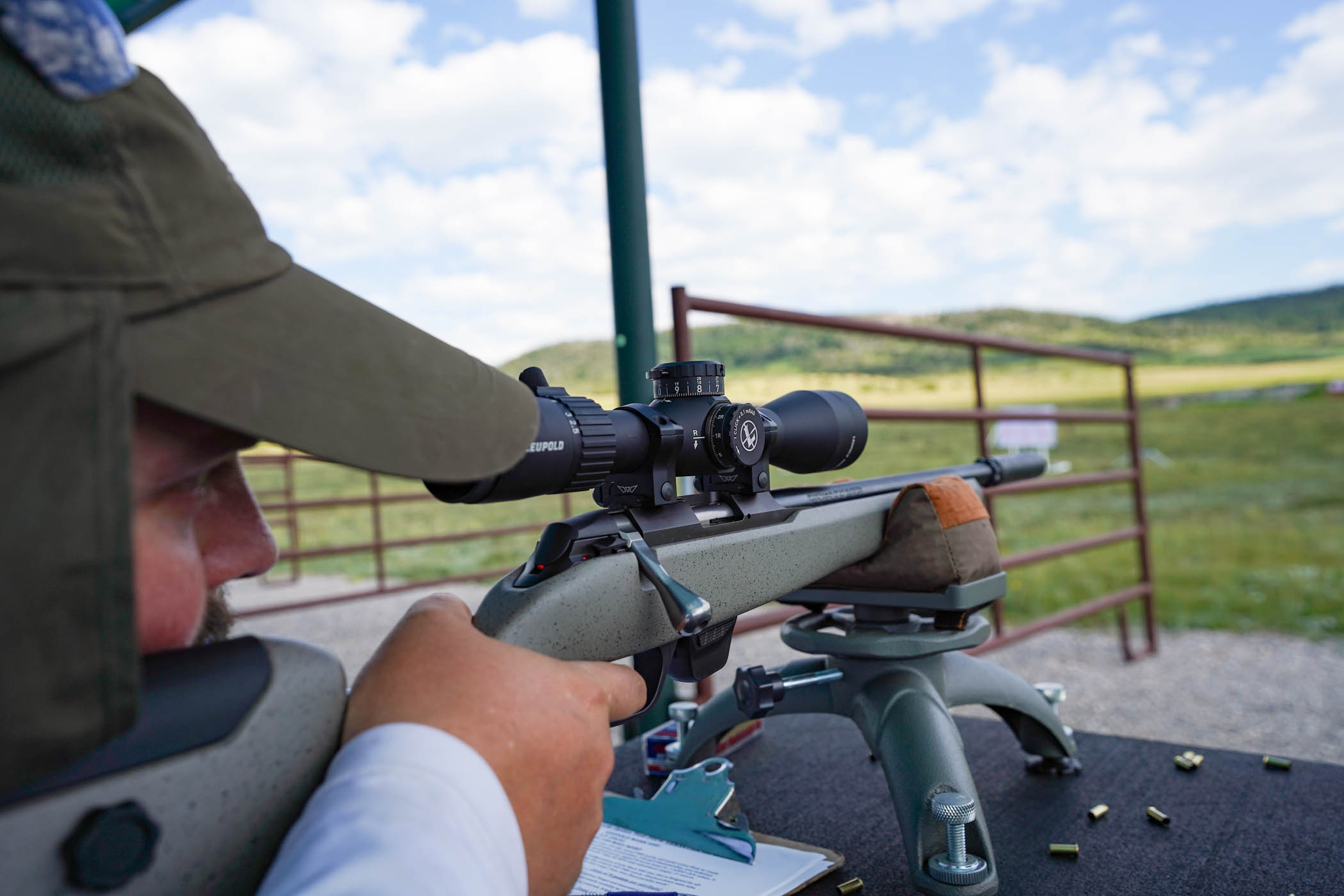
Truth is, this handy little scope in the new Mark 4HD line is all of the above. We named it the best tactical hunting scope as a testament to its ability to crossover. Our test sample came with a second-plane reticle, but the versatility is further boosted by the first-plane version of the 2.5-10×42 because of the additional precision work that reticle enables.
Still, our second-plane sample was no slouch, though we did have minor tracking issues. The Zero Lock elevation turret is big, easy to operate, and the indexing is some of the best in the field. The push-button illumination is fast, smart, and elegant, and the throw lever on the oversized zoom dial enables quick magnification changes.
The reticle, with half-MIL steps, offers four MILs of holdover and windage, and has the added benefit, rare in this category, of ranging lines at the ends of the illuminated stadia. In the second-plane configuration, the scope has to be on 10x in order to subtend correctly, but that modest magnification is perfect for most shooting and hunting purposes when precise sub-tension is required.
Testers thought the scope was overpriced compared to its peers, but the Mark 4HD offers a ton of utility in a tough, nimble package.
Best Western Hunting Scope: Maven RS1.2 2.5-15×44
Score Card
- Optical Performance: Very good
- Mechanical Performance: Excellent
- Design: Excellent
- Price/Value: Very good
Key Features
- 30mm tube
- First-plane MOA-2 reticle (also available in SHR-MIL and SHR-W MOA)
- Exposed re-zeroable elevation turret, capped re-zeroable windage turret
- Turrets tuned to .25 MOA clicks
- 100 MOA (29 MIL) elevation adjustment range
- 5.6 yards to infinity side parallax control
- 11-step red center-dot illumination
Pros
- 6x magnification range
- Brass zero stop
- Tool-less turret removal
- Excellent indexing throughout
- Premium extra-low-dispersion glass
Cons
- Reticle too busy for some hunting situations
- Illumination too faint
- Reticle references not visible until about 5x
With this bright, tough, and lovely scope, Maven has given long-range hunters everything they could want. You’re a holdover hunter? The first-plane reticle has useful elevation and windage references. Oh, you’d rather dial your aiming solution? The exposed elevation dial turns with precise positivity and offers an astonishing 100 MOA of elevation travel. You prefer MIL-based reticles? The RS1.2 has Maven’s SHR reticle in MIL subtensions. Or you’re an MOA shooter? The scope comes in the simplified SHR-W MOA-based reticle, or the busier MOA-2 of our test sample.
With so many options, Maven has doubled down on its value proposition to Western hunters. This is a scope that will reach way out there for a distant pronghorn or elk, and doubles as a serviceable steel-target rig.
The glass is excellent; it finished near the top of our low-light test, beating several 50mm scopes. The controls are smooth and precise. While we generally prefer capped turrets on a hunting scope, Maven’s tool-less exposed turret is both elegant and functional, and provides easy in-the-field access to re-zero the turret and set its excellent zero stop.

Among the elements that didn’t quite live up to our expectations, the center-dot illumination is precise and in the right light makes a very nice aiming point. But the illumination doesn’t help much in daylight conditions. At 26.4 ounces, this is a hefty optic, which makes it less than ideal for lightweight hunting rifles. On the other end of the spectrum, though, its extreme close focus and fine reticle makes it a great precision rimfire rig.
At $1,200, the RS1.2 is a pricey scope, but considering its dizzying number and quality of amenities, the test team felt it was fairly priced.
Users will have to decide for themselves if Maven’s more-is-more approach is for them. Half our test team loved the sheer versatility this scope offers; the other half felt there’s just too much going on, to the degree that it might distract from the sort of fast, instinctive shooting that often defines, and ultimately ends, a Western hunt.
Best Mid-Price Hunting Scopes: Reviews & Recommendations
Best Overall: Zeiss Conquest V4 3-12×44
Score Card
- Optical Performance: Excellent
- Mechanical Performance: Very good
- Design: Very good
- Price/Value: Good
Key Features
- 30mm tube
- Second-plane Zeiss #20 Z-Plex duplex reticle
- Exposed elevation turret tuned to .25 MOA clicks
- 70 MOA internal adjustment range
- Capped re-zeroable windage turret
- Also available in 3-12×56 version
Pros
- Brass ballistic stop
- Useful 4x zoom range
- Premium glass and coatings
- Extremely lightweight at 18.2 ounces
Cons
- Parallax fixed at 100 yards
- Duplex reticles limits precision work
For those of us who for years have appreciated the honest value of Zeiss’s Conquest scopes, there’s a new object of our affection. Zeiss has introduced a new configuration of the V4, in a light, simple, and bright 3-12×44 that is built for hunters who want a fast, uncluttered scope but who intend to dial longish shots.
The new Conquest V4 doesn’t have an independent parallax knob — parallax is fixed at 100 yards — and neither does it have illumination. It has a simple Z-Plex reticle with no elevation or windage holds. The scope’s lone adjustment, besides its velvety power-changing ring, is an exposed elevation turret that turns with positivity.
The idea is that a hunter, in the moment of engagement, doesn’t need to be distracted by choices. Do I hold on reticle references? Or do I dial to distance? Do I focus my target? What magnification do my reticle subtensions require? All those decision — and indecision — points are introduced into the moment by scopes that have the distracting number of amenities that brands think hunters want. With its V4, Zeiss is making a bet that a certain hunter wants less, not more.
The 3-12-power scope is suited to any number of hunting situations, and its extremely light 18.2-ounce heft makes it a good choice for a mountain rifle. Given that its elevation turret is designed to be dialed, Zeiss has added its solid brass Ballistic Stop, giving shooters a very useful return-to-zero feature. Turret indexing is bold and clear, further enhancing its dial-ability. Testers had mixed opinions of the exposed turret; some wanted the elevation turret capped to avoid inadvertent turning in the field. Others felt it’s best uncapped to facilitate fast dialing. The Ballistic Stop is an important feature so that users can easily confirm their zero on the exposed turret.
The glass and coatings are excellent, controls move smoothly and surely, and the lack of superfluous knobs gives the Zeiss a streamlined, elegant style. At just under $850, the Japan-sourced Conquest is a good value in a very serviceable hunting scope.
Best for Whitetails: Vortex Viper HD 2-10×42
Score Card
- Optical Performance: Very good
- Mechanical Performance: Very good
- Design: Good
- Price/Value: Good
Key Features
- 30mm tube
- Second-plane Dead-Hold BDC
- Capped turrets tuned to .25 MOA
- 135 MOA total elevation adjustment
- 100-yard fixed parallax
- Red center-dot illumination
Pros
- Simple, set-it-and-forget-it operation
- Reticle has useful bullet-drop references
- Smart push-button illumination
- Easily re-zeroable turrets
- Compact: 12.1 inches long and 19.9 ounces
Cons
- Could use a throw lever
- Reticle isn’t suited for precision work
With very few exposed controls and a bombproof build, this little Vortex would be at home on a mountain rifle, or a backcountry horseback hunt that requires shucking your gun in and out of a saddle scabbard. But it’s also just about the perfect mid-distance whitetail scope, with a fast and precise-enough reticle, and an excellent illumination for both daylight and last-light visibility.
The heart of the scope is Vortex’s excellent Dead-Hold BDC reticle with a .13-MOA center dot and three elevation hashes that start 1.5 MOA below the crosshair and then are spaced 3 MOA apart. The ballistician in me notes that they don’t really conform to the parabola of a bullet, which drops geometrically, not arithmetically. But users can tune the drops to their specific load using Vortex’s Long Range Ballistics Calculator, which helps expand the utility of the reticle. The reticle has 8 MOA of windage holds, at 2 MOA spaces, on either side of the crosshair.
The capped turrets are simple and useful, in keeping with the reticle, and the elevation turret enables an astonishing 135 MOA of travel. The spring-loaded turret dial is easy to re-zero in the field, though we’d like to see more visible turret indexing.
While the Viper HD doesn’t have an external parallax control — parallax is fixed at 100 yards — we only struggled with target acquisition inside 25 yards, leading some testers to note this isn’t an ideal rimfire scope. Beyond about 600 yards we again struggled with focus, as target edges didn’t seem especially sharp. But in the middle distances, the image is clear and bright, and reticle visibility is excellent.
Visibility is further enhanced with Vortex’s very good push-button illumination that lights up the center dot. We subtracted points for the dot’s significant flaring, especially at high intensities.
Testers were mixed on the price. At about $600 real-world street price, half the team thought it was priced right for its wide capabilities. The other half thought it was overpriced, considering all the amenities it doesn’t have. That shows you that, even more than ergonomics and design, price/value is a subjective assessment.
The use cases for this scope are infinite. It’s a decent AR carbine scope. It would be at home on an expedition rifle. But we reckoned that, given its versatility, its simple operation, and its mid-range talents, that it’s the best whitetail scope in our test, with plenty of talents for work well beyond deer country.
Eotech Vudu X
Score Card
- Optical Performance: Very good
- Mechanical Performance: Very good
- Design: Good
- Price/Value: Good
Key Features
- 30mm tube
- Second-plane BD1 (Ballistic Drop 1) reticle
- Capped turrets tuned to .25 MOA
- 80 MOA total elevation adjustment
- 25 yard to infinity side parallax
- Red center-cross illumination
Pros
- Simple and durable operation
- Reticle has useful bullet-drop references
- Easily re-zeroable turrets
- Useful throw lever
Cons
- Derivative design
- Illumination could be brighter
- Turret clicks are mushy
If you think you’re seeing a ghost, you’re not all wrong. This a brand-new version of Eotech’s venerable Vudu line, but sourced in the Philippines, rather than Japan, with some familiar and some new attributes. Some of those attributes may remind shooters of another ghost: Nikon’s now-defunct line of rifle scopes.
The main derivative detail of the X version of the Vudu is the circular holdover references on the second-plane reticle’s elevation stadia. They reminded testers of Nikon’s Spot On reticle, with similar circular references that enable fast, precise-enough aiming. The Vudu X has four circles, and they’re spaced at 2, 4, 6, and 8 MOA below the crosshair, for easy referencing.
The capped turrets are tuned to .25 MOA, making reticle/turret agreement easy and clear. The turrets are re-zeroable, but users have to entirely remove the dials in order to reset them. That, and the mushy clicks, are disappointing given the other tight attributes of the scope. We like the smooth and firm power-changing dial and the aggressive throw lever. The 25-yard parallax is a nice touch, giving this otherwise mid-range scope some close-in capability.
The Vudu X’s glass was disappointing, given the gem-bright glass of the original Vudu. But the new iteration is about half the price of the Japan-sourced scope. Testers still thought that, at about $850, the Vudu X is overpriced, but recommended it for everything from all-around big-game hunting to limited tactical work.
Riton 5 Primal 2-12×44
Score Card
- Optical Performance: Good
- Mechanical Performance: Very good
- Design: Good
- Price/Value: Poor
Key Features
- 30mm tube
- Second-plane RDH duplex reticle
- Capped low-profile turrets tuned to .25 MOA
- 90 MOA total elevation adjustment
- 15 yard to infinity side parallax
- Red center-dot illumination
Pros
- 6x magnification zoom
- Precise illuminated aiming point
- Very fast reticle deployment
- Tactile, grippy turret dials
- Three-height throw lever
Cons
- Odd configuration
- At over $700, pricey
- Underwhelming glass
This is an oddball. On the one hand, the duplex reticle enables very fast both-eyes-open shooting, a capability that’s further enhanced with a bright pinpoint center-dot aiming dot. On the other hand, that’s an attribute better suited to an LPVO, not a full-size 1.5-pound scope.
The turrets are big, meaty, and fun to turn. But they’re also capped, which limits their utility for in-the-moment dialing. Then there’s the glass, which scored well on our resolution range but near the bottom of low-light performance. Testers noted peripheral fuzziness and some color fringing.
But I’m a firm believer that for every scope there’s a perfect use, and the Riton would be a wonderful mid-range bullseye optic. The illuminated center dot, which looks to be about .25 MOA, centers the eye, and the side parallax sharpens the target. The heavy scope settles nicely on either benches or bags. The three-position throw lever makes magnification changes fluid and fast. And, with a 15-yard close focus, it would make a great 50-meter rimfire rig.
That said, the 5 Primal is available with a hash-style reticle with extensive elevation and windage references around a floating .5 MOA center dot. That’s probably the better option for shooters and hunters who want to take the Riton off the bench and into the field.
Best Budget Hunting Scopes: Reviews & Recommendations
Best Value: Bushnell R5 4-12×40
Score Card
- Optical Performance: Good
- Mechanical Performance: Very good
- Design: Good
- Price/Value: Good
Key Features
- 30mm tube
- Second-plane DOA-LRH800 illuminated reticle
- Capped, re-zeroable turrets tuned to .25 MOA clicks
- 60 MOA windage/elevation adjustment range
- 10 yards to infinity side parallax control
- 6-step red center-dot illumination
Pros
- 4x magnification range
- Versatile hunting reticle with elevation and wind holds
- Excellent illumination with off settings between intensity steps
- Reticle references informed by Bushnell Ballistic App
Cons
- Poor turret/reticle tracking
- Turrets tighten noticeably as they bottom out
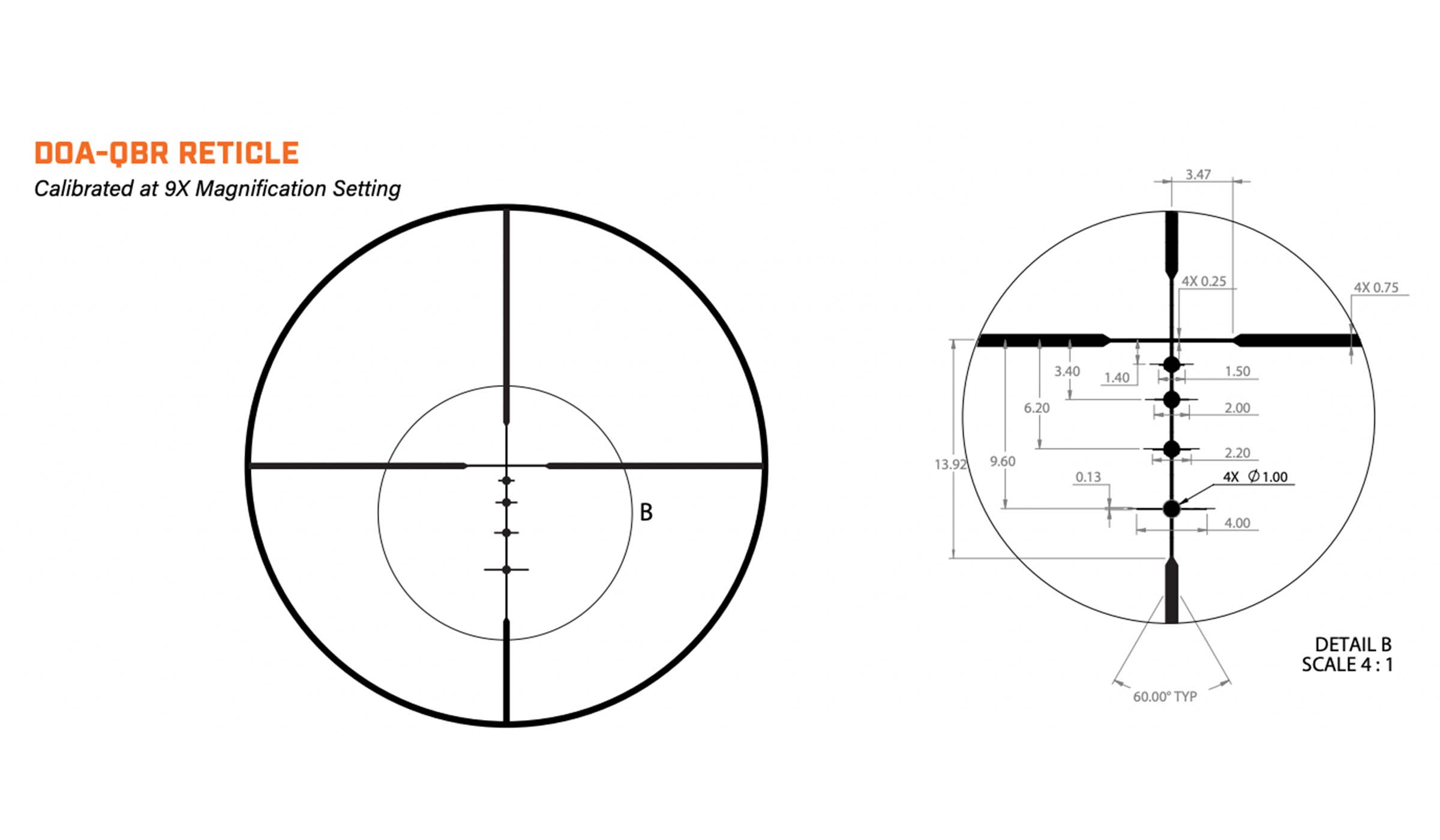
Bushnell has packed a ton of features into its new R5 line. The 4-12×40 in our test has a very good center-dot red LED illumination, and the side parallax focuses targets as close as 10 yards, making this a good air gun or rimfire scope. The second-plane reticle has decent references out to 800 yards. And the short (11.5-inch) scope nicely fits AR-pattern rifles or youth guns.
The accessible price (MSRP is $239 but you can probably find this for under $200) makes it a smart choice for a wide variety of hunting and shooting platforms, especially for budget gunners.
But there’s a cost to all those amenities in a budget scope, and users will pay it in creaky controls. We noticed that the zoom dial turns easily at lower magnifications, but then tightens toward higher powers. Same with the turrets; they turn easily and sharply in the middle of their adjustment range, but as they near the higher and lower ends of their travel, they start to stick. That’s a sign of cheap erector components, and we worry that users who really force the turrets could end up breaking them.
The Bushnell’s glass was better than we expected; it posted a very good resolution score and the 40mm scope did okay in low-light evaluations.
The DOA reticle is decent, offering MOA-based holds out to 800 yards and windage holds in both 5 and 10 mph right-angle winds. But the references are very fine, and some testers noted that they disappear against cluttered backgrounds.
Still, for a hunter who wants a scope with lots of moving parts and amenities, the R5 is priced right, and Bushnell’s lifetime warranty is a good backstop in case any of those moving parts stop moving. Given its abundant hunting chops for a very fair price, we awarded the R5 with our great buy award for the hunting-scope category.
Best Entry-Level: Bushnell R3 3-9×40
Score Card
- Optical Performance: Fair
- Mechanical Performance: Good
- Design: Fair
- Price/Value: Very good
Key Features
- 1-inch tube
- Second-plane DOA-QBR reticle
- Capped re-zeroable turrets tuned to .25 MOA clicks
- 65 MOA windage/elevation adjustment range
- Reticle references out to 600 yards
Pros
- 3x magnification range
- At about $120, a good value
- Bullet drop holds informed by Bushnell ballistic app
Cons
- Fixed parallax causes some focus issues
- No illumination
- Spongy turret tactility
With its new R3 family of optics, Bushnell has a new entry-level scope that offers some very appealing attributes for a beginning hunter or a shooter on a budget.
First is its price. For a little over $100 you get an honest scope with enough reticle references to make informed shots at middle distances. The glass is murky but it’s good enough for 90 percent of a hunter’s time in the field. The re-zeroable turrets are mushy but serviceable. In short, it’s a solid effort.
We’ve been fans of Bushnell’s DOA reticle since it came on the scene in the brand’s Trophy line of scopes nearly 20 years ago, and the combination of bullet-drop references and simple windage marks makes it a fast, simple, and effective hunting reticle. With a 100-yard zero, shooters have four 1 MOA dots for elevation holds, and the top of the extended duplex post provides a 600-yard reference. It’s not overly precise, but at least the references are informed by ballistic parabolas. Users can further fine-tune their bullet velocities to the reticle by pairing it with the free Bushnell Ballistic App.
We worry about the durability of this scope, though it was one of the few budget scopes that didn’t fog after a freeze-thaw test. Additionally, the Bushnell’s fixed parallax limits its utility at both very short and very long distances. But those are relatively minor quibbles for a scope that would be at home on a first squirrel gun or deer rifle.
Best Entry-Level Rimfire Scope: Redfield Rebel 2-7×32
Score Card
- Optical Performance: Poor
- Mechanical Performance: Fair
- Design: Fair
- Price/Value: Good
Key Features
- 1-inch tube
- Second-plane non-illuminated duplex reticle
- Re-zeroable capped turrets tuned to .25 MOA clicks
- 30 MOA internal windage and elevation adjustment
- 50-yard fixed parallax
- 12.6 ounces
Pros
- Few exposed controls
- At under $100, an accessible price
- Decent rimfire scope
Cons
- Poor construction
- Narrow utility
My delight at having Redfield back in our optics test faded as its rifle scopes underwhelmed on our evaluation range. No scope failed any task, but of the three in our field, none particularly wowed us or reminded us of this brand’s grand heritage.
Redfield is one of the former greats of the American optics industry, going afield with at least two generations of sportsmen. But then the rise of very good Japanese optics, more affordable at the time than the American-made glass, took market share, and European brands made a successful bid for American hunters. Venerable domestic brands like Redfield, Weaver, and Bausch + Lomb faded into the background. Leupold made a short play for Redfield, which is now the house optics brand for Academy Sports.
The 2-7×32 Redfield is the most niche of the trio. There’s not a lot to this scope, but at a $99 retail price, it’s not intended as a utility player. Instead, it’s intended as a first scope for a kid’s .22, or maybe a light-recoiling deer rifle. With that use-case in mind, the Rebel is adequate, but it’s not going far beyond its low expectations.
The duplex reticle is clean and standard, and the turrets, tuned to .25 MOA clicks, actually moved with more authority and tactility than we expected. An even more surprising attribute is that the turrets are easily re-zeroed.
But the Redfield’s glass is pretty cringy, and given that our sample fogged up after a freeze-thaw test, we worry about the overall durability of the build. But if you treat it well, it should get a few years of use before buyers graduate out of the entry-level market into their next scope, which given its renaissance might well be a Redfield.
Best Bargain: Monstrum Guardian 3-9×40
Score Card
- Optical Performance: Fair
- Mechanical Performance: Fair
- Design: Fair
- Price/Value: Good
Key Features
- 1-inch tube
- Second-plane “MOA-Dot” reticle
- Red and green full-reticle illumination
- Capped turrets tuned to .25 MOA clicks
- Objective-bell parallax control, 25 yards to infinity
Pros
- Lots of attributes for a price-point scope
- Re-zeroable turrets
- Useful throw lever
- At $50, a screaming bargain
- Ships with shoot-through rings and flip-up lens caps
Cons
- Poor turret indexing
- Some lens fogging
- Squinty glass
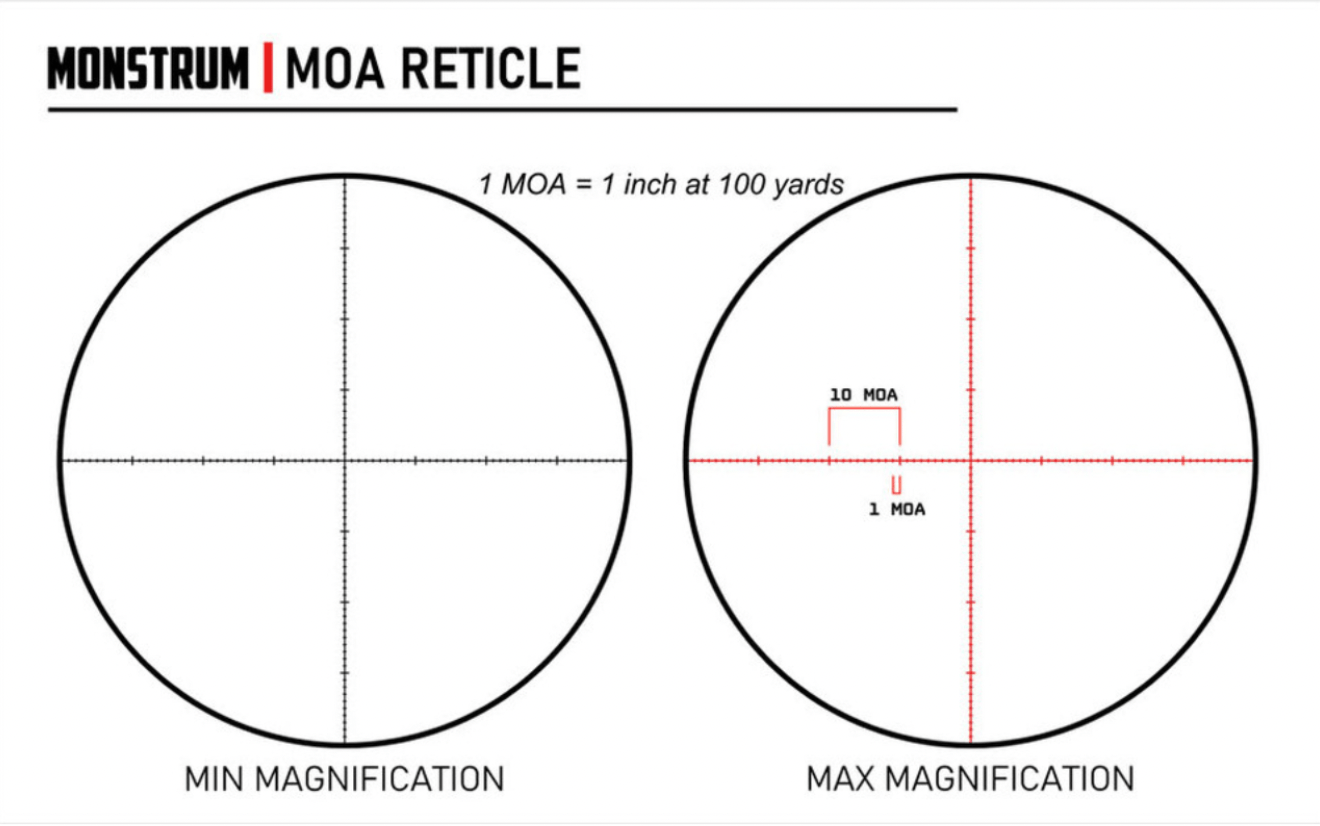
How on earth can a manufacturer bring to market a serviceable rifle scope for $50? And include a set of rings with the optic? That’s the question we’ve been asking for a couple of years, as we’ve seen the brand Monstrum selling boatloads of scopes through Amazon’s online retail store. So we invited Monstrum to our test, partly to prove to ourselves that their cheap optics aren’t actually a bargain.
So color us surprised to find that their 3-9×40 Guardian isn’t that bad. Okay, it flunked the low-light test and testers reported headaches and squints after a session behind the scope, but on matters that matter for a rifle scope, the Monstrum fared decently. Its turrets tracked perfectly with its reticle and its illumination fired up the reticle in both greens and reds. Its objective-bell parallax is clunky, but focused targets from about 35 yards to way out there.
There are some significant durability issues with this scope. Its internal lenses fogged after a freeze-thaw test, and we noticed an unsettling vibration in the erector system, like the buzz of a mouth harp, if we tapped the scope. The reticle, which Monstrum calls an MOA-Dot, is useless for anything but crosshair aiming, the “dots” looking as lumpy and indistinct as ants on a log.
But, as testers kept saying, “What do you expect for a $50 scope?” Truth is, we expected a lot less. With its lifetime warranty, the Monstrum represents a pretty appealing entry-level scope for a rimfire or air gun.
Best Straight-Wall: Hawke Vantage IR Straight-Wall Marksman 3-9×40
Score Card
- Optical Performance: Good
- Mechanical Performance: Very good
- Design: Good
- Price/Value: Very good
Key Features
- 1-inch tube
- Second-plane Straight-Wall Marksman BDC MOA-based reticle
- Capped turrets tuned to .25 MOA values
- 100 MOA total windage/elevation adjustment range
- 10-step red/green illumination
- Optimized for 450 Bushmaster, .45/70 Gov’t, 350 Legend, 400 Legend
- Parallax set at 100 yards
Pros
- Reticle has easy-to-see distance references
- Good mounting dimensions
- Handy illumination
- At about $220, a fair price
Cons
- Turrets are small and indistinct
- Turrets aren’t re-zeroable
- Turrets aren’t properly indexed
This scope absolutely ruled our four-scope straight-wall cartridge shoot-off, thanks to a clear and useful reticle that literally gives shooters specific hold-over directions. You want to zero at 100 yards? The reticle has a 100-yard reference, with the number etched on the reticle. There are other numeric etching at 150, 200, 250, and 300 yards. I know what you’re saying: all those numbers probably clutter the view.
You’re not wrong; the references are a little busy. But our testers found them to be fast, precise, and idiot-proof.
“I was skeptical about lobbing a 300-grain bullet out at 300 yards, but I just held where the scope told me and rang steel on my first shot,” noted tester Dale Manning. “It’s precise, but it’s also really fast in real-world field conditions.”
The very specific references that make this the best straight-wall cartridge scope in our test limit its wider utility. Those etched bullet drops aren’t going to help a rimfire shooter or a hunter who’s using a .30/06 or 6.5 Creedmoor. And testers hated the Hawke’s turrets, which are small and hard to turn and lack indexing.
But if you’re in the market for a scope that will lob bullets surprisingly precisely, from both 350 and 400 Legends, 360 Buckhammer, 450 Bushmaster, and .45/70 Gov’t, this is absolutely the scope for you.
Best Budget Big-Game: Redfield Rebel 6-24×50
Score Card
- Optical Performance: Poor
- Mechanical Performance: Good
- Design: Fair
- Price/Value: Excellent
Key Features
- 30mm tube
- Second-plane “Accuranger” hash-style reticle
- Capped turrets tuned to .25 MOA clicks
- 11-step red illumination
- 50 yards to infinity parallax
Pros
- At $249, a very accessible price
- 50mm objective useful for low-light hunting
- MOA-based reticle useful for mid-range precision shooting
- Daylight-bright illumination
Cons
- Mushy turrets
- Durability concerns
As noted elsewhere, it’s nice to see Redfield’s distinctive red badge in our test, and this iteration of the Rebel scored better across the board than the rimfire scope. Of course, it’s more than twice the price, but we found a lot to like for $250, starting with the configuration.
This is a bit of an oddball for the versatile scope category, since you’d expect a 6-24X scope in the precision field. But there’s not enough talent in the Redfield to compete with true precisions scopes, and it’s a little overbored for many hunting situations. Still, if you’re a low-light hunter who wants simple reticle references, you can do worse than this big scope with both illumination and parallax.
The glass is underwhelming, and we found the turrets tinny. The Redfield was one of several budget scopes that fogged when subjected to a freeze-thaw test. But the scope tracked well, and does double duty as a mid-range hunting scope or a target optic. The close focus and versatile reticle make it a decent choice for a precision rimfire scope.
As we noted, Redfield is the house brand for Academy Sports, and frequent shoppers may well find this on sale for significantly less than its listed price, making it an even better deal on a big, powerful optic.
Great Buy Straight-Wall: Athlon Neos Straight-Wall 3-9×40
Score Card
- Optical Performance: Fair
- Mechanical Performance: Good
- Design: Good
- Price/Value: Very good
Key Features
- 1-inch tube
- Second-plane BDC 300 Straight-Wall reticle
- Ballistic drops tuned to specific straight-wall calibers and bullets
- Red LED center-cross illumination
- Capped turrets tuned to .25 MOA values
- 80 MOA total windage/elevation adjustment range
- Parallax set at 100 yards
Pros
- With proper zero and bullets, reticle references are fast and precise
- Low mounting dimension fit a variety of rifle receivers
- One of few entry-level straight-wall scopes with illumination
- At about $175, a fair price
Cons
- Illumination module is large and ungraceful
- Reticle references are small and imprecise
- Spongy turret clicks
None of the straight-wall scopes in our mini test are particularly pricey, but this model from Athlon offers a number of appealing attributes, places heavy bullets on target out to 300 yards, and costs around $175, making it the best value in our collection.
Like its competitors, the Neos doesn’t have memorable glass or controls. But that’s not why you’re buying this. You are looking for an inexpensive get-‘er-done optic, and the Athlon lives up to that expectation. Its BDC 300 Straight-Wall illuminated reticle lives up to its promise as a decent 300-yard punkin-lobber. The reticle, basically a modified duplex, also has windage hashes for holds in 5- and 10-mph right-angle winds, but we didn’t test the veracity of those references.
Like the other second-plane reticles in this mini-test, the Athlon’s reticle drops work only at the highest magnification, but at 9-power the scope handles well, providing good magnification of the target and decent light transmission. The reticle, though, is too fine; we’d like to see the elevation stadia and bullet-drop dots a little heavier. Red illumination helps visibility, but the illumination module, awkwardly located on the scope’s eyepiece, is clunky and graceless, though easy to reach to turn on and off.
The Athlon’s capped turrets are fairly crisp, and are re-zeroable, though we’d like to see bolder and more visible indexing on the dials. The scope’s parallax is fixed at 100 yards. The 1-inch main tube has plenty of space for various mounting options, and the 40mm objective allows for low-profile mounting. While the scope’s reticle is tuned to very specific straight-wall cartridge bullets (250-grain Hornady FTX in 450 Bushmaster, 325-grain FTX in .45/70 Gov’t, 150-grain Winchester Extreme Point in 350 Legend, and 200-grain Remington Core Lokt in 360 Buckhammer), the scope would be fine on a rimfire or modern center-fire rifle.
At $179 retail price, we reckoned the Neos brings a lot to the straight-wall party, and wins our great buy award in this small and tightly defined category of versatile scope.
Final Thoughts on the Best Hunting Scopes
We realize that hunters are a very singular population. Even within the narrow category of whitetail hunter, some want a simple 3-9×40 scope with a duplex reticle and capped turrets. But their neighbor might want a scope with a first-plane illuminated reticle and exposed turrets to dial their longish shots.
The category includes Midwestern squirrel hunters, who have very specific rimfire requirements. Then there’s Western elk hunters, who put a premium on low-light performance. And sheep hunters, who want a light and durable optic.
Given that variation within the marketplace, the industry has provided a wide range of models, features, and prices. Our test is designed to consider each scope’s use-case, and then guide readers to the highlights and shortcomings of each submission.
Maybe as an extension of our own expectations of a scope, we reward those that perform at least a couple of tasks adequately. Maybe that whitetail scope doubles as a capable rimfire optic. Or maybe that hard-wearing sheep scope can also ring steel at a mile. Those are the scopes that demonstrate versatility, which is the ultimate attribute of an all-around hunting scope.

